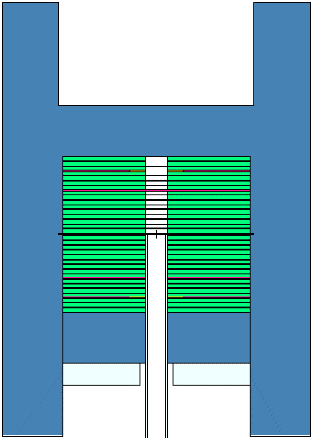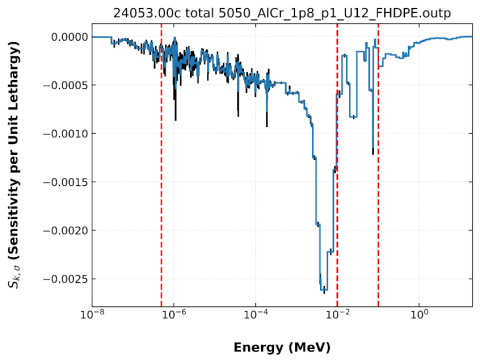The purpose of this project is to create detailed designs for criticality experiments sensitive to iron and chromium in the low intermediate, high intermediate, and fast neutron energy ranges. The experiments are designed for the Comet Critical assembly, located at the Nevada National Security Site (NNSS), which is managed by Los Alamos National Laboratory (LANL). Determination of specific materials for use in the experiment including the assembly reflector, fuel plates, iron/chromium test plates, and moderator plates is executed. Materials already available at LANL are utilized where possible, and configurations of the fuel, test, and moderator plates are determined to create a critical system. These configurations are a series of repeated units consisting of the aforementioned plates, and simulations using MCNP are performed to evaluate each configuration for energy, criticality, and sensitivity of the neutron distribution produced. Fig. 2 shows the designed Comet assembly model within MCNP, including the reflector and using MCNP universes.
Team: Alexander Hauck, Cassandra Clute, Alexander Fung, Max Rose
Project Advisors: Prof. Yaron Danon, Dr. Nicholas Thompson (LANL), Jesson Hutchinson (LANL), & Noah Kleedtke (LANL)

Members of the design group
Project Motivation
Fissionable materials pose a serious threat when proper safety precautions are not taken, and the field of nuclear criticality safety aims to prevent accidents from these nuclear materials. System geometry, fuel enrichment, material types, and many more factors must be considered to make conclusions about the system’s criticality. High-fidelity modeling therefore requires accurate data to properly describe the system. Cross-section values across energies are essential to depict how the fission neutrons interact with each material present. Two ubiquitous elements within the structural components of nuclear systems are iron and chromium. These two have had significant benchmark testing to ensure accurate data within the fast and thermal energy regions. However, within the intermediate energy region between fast and thermal, there are only a few recorded benchmarks. This is an issue, as the data from these benchmarks do not agree with one another, and various nuclear data libraries (ENDF/B-VIII.0, ENDF/B-VII.1, JEFF-3.3, JENDL-4.0, etc.) report different values. Therefore, the models used by different companies and laboratories for systems with these common elements will conclude differing results. Further benchmarks must be used to provide nuclear data evaluators with more information to validate the cross-section values within these energy regions.

Figure 1 - MCNP model of Comet assembly with reflector.
Project Description
The purpose of this project is to create detailed designs for criticality experiments sensitive to iron and chromium in the low intermediate, high intermediate, and fast neutron energy ranges. The experiments are designed for the Comet Critical assembly, located at the Nevada National Security Site (NNSS), which is managed by Los Alamos National Laboratory (LANL). Determination of specific materials for use in the experiment including the assembly reflector, fuel plates, iron/chromium test plates, and moderator plates is executed. Materials already available at LANL are utilized where possible, and configurations of the fuel, test, and moderator plates are determined to create a critical system. These configurations are a series of repeated units consisting of the aforementioned plates, and simulations using MCNP are performed to evaluate each configuration for energy, criticality, and sensitivity of the neutron distribution produced. Fig. 2 shows the designed Comet assembly model within MCNP, including the reflector and using MCNP universes.

Figure 2 – Neutron flux (left) and Photon flux (right) from Nuclear Weapon detonation spectrum.
Results and Accomplishments
Designs are evaluated based on their values for k¬eff (to determine if the system is critical), percentage of neutrons within the fast/intermediate energy regions (to ensure the energy range is appropriate), total system weight (to stay under the maximum allowed by the Comet assembly), and the magnitude of the sensitivity within the given energy region (to minimize the cross-section uncertainty). Fig. 3 shows the relative sensitivity per lethargy profile (blue step function) with associated uncertainty (black vertical lines) for an HDPE-moderated MCNP simulation of the Comet assembly using 5050 AlCr test plates. The profile shows the Cr-53 capture cross-section for the test, with four energy regions separated by the dotted red lines. The HDPE moderator slows the neutrons from the fast and high intermediate energy regions to produce higher sensitivity magnitudes within the low intermediate energy region. A figure of merit was developed to compare designs using these factors while the remaining criteria were met implicitly upon creation of each design. The figure of merit is a discontinuous function producing positive values for the desired keff range and negative values if the design does not fall within this range. Additionally, the sensitivity is integrated between the two bounds of the desired energy region to maximize this value. It is then divided by the total system weight (to minimize weight).
Currently, three of six designs (high intermediate for Fe & Cr, low intermediate for Fe) have been determined to meet their design criteria, and these designs will further utilize the figure of merit to optimize their values for plate thickness and number of repeated units in the assembly. Another design (low intermediate for Cr) is near the design criteria and will utilize the figure of merit to determine which new designs meet the criteria as well as which design is the most desirable out of those that do. Finally, the two fast energy designs (Fe & Cr) will be determined using a similar method. Future work will employ the use of machine learning optimization algorithms to finalize the designs by determining the optimal test and moderator plate thicknesses as well as the number of repeated units for the selected configuration.
This project has been awarded as the best undergraduate presentation in the Nuclear Criticality Safety track at the American Nuclear Society 2022 Student Conference.